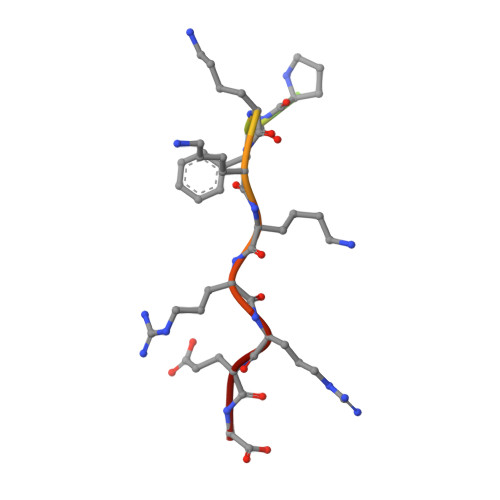Probing the specificity of binding to the major nuclear localization sequence-binding site of importin-alpha using oriented peptide library screening.
Yang, S.N.Y., Takeda, A.A.S., Fontes, M.R.M., Harris, J.M., Jans, D.A., Kobe, B.(2010) J Biol Chem 285: 19935-19946
- PubMed: 20406804
- DOI: https://doi.org/10.1074/jbc.M109.079574
- Primary Citation of Related Structures:
3L3Q - PubMed Abstract:
Importin-alpha is the nuclear import receptor that recognizes the classic monopartite and bipartite nuclear localization sequences (cNLSs), which contain one or two clusters of basic amino acids, respectively. Different importin-alpha paralogs in a single organism are specific for distinct repertoires of cargos. Structural studies revealed that monopartite cNLSs and the C-terminal basic clusters of the bipartite cNLSs bind to the same site on importin-alpha, termed the major cNLS-binding site. We used an oriented peptide library approach with five degenerate positions to probe the specificity of the major cNLS-binding site in importin-alpha. We identified the sequences KKKRR, KKKRK, and KKRKK as the optimal sequences for binding to this site for mouse importin-alpha2, human importin-alpha1, and human importin-alpha5, respectively. The crystal structure of mouse importin-alpha2 with its optimal peptide confirmed the expected binding mode resembling the binding of simian virus 40 large tumor-antigen cNLS. Binding assays confirmed that the peptides containing these sequences bound to the corresponding proteins with low nanomolar affinities. Nuclear import assays showed that the sequences acted as functional cNLSs, with specificity for particular importin-alphas. This is the first time that structural information has been linked to an oriented peptide library screening approach for importin-alpha; the results will contribute to understanding of the sequence determinants of cNLSs, and may help identify as yet unidentified cNLSs in novel proteins.
Organizational Affiliation:
School of Chemistry and Molecular Biosciences, Institute for Molecular Bioscience and Centre for Infectious Disease Research, University of Queensland, Brisbane, Queensland 4072, Australia.
















